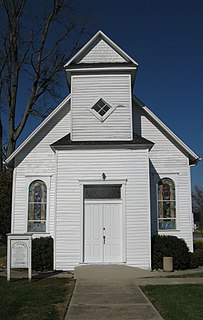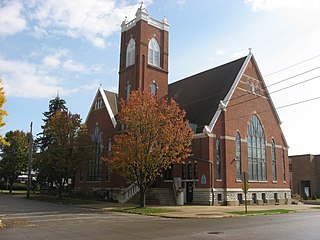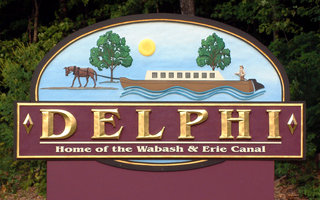
The Mount Zion Methodist Episcopal Church is a historic Methodist church located in Union Township, Delaware County, Indiana. It was built in 1867, and is a modest, one-room, brick church with a reconstructed bell tower. It measures 46 feet by 36 feet and sits on an uncut Indiana limestone foundation.

The Big Run Baptist Church and Cemetery, also known as Franklin Township Historical Society, is a historic Baptist church and cemetery located at 6510 South Franklin Road in Franklin Township, Marion County, Indiana. The church was built in 1871 as a Baptist meeting house and served the church congregation until 1977. It is a one-story, gable front brick building with Italianate style design elements. The associated cemetery was established in 1854, with one stone dated to 1841. The most recent burial was in 1986. Also on the property is a contributing privy constructed about 1920. The Franklin Township Historical Society acquired the property and now uses the building as a historical museum.

Aurora First United Methodist Church, also known as the First United Methodist Church of Aurora and Aurora Methodist Episcopal Church, is a historic Methodist church located at 304 Third Street in Aurora, Dearborn County, Indiana. It was built between about 1855 and 1862, and is a two-story, gable front, Greek Revival style brick building. It measures 45 feet, 6 inches, wide and 95 feet deep. A limestone front was added to the original building in 1903 and one-story rear addition built between 1885 and 1888. The church was remodeled in 1954.

Moore's Hill United Methodist Church, also known as Methodist Episcopal Church, is a historic Methodist church located at 13476 Main Street in Moores Hill, Dearborn County, Indiana. It was built in 1871, and is a simple one-story, gable front, brick building with Greek Revival and Italianate style design elements. It rests on a limestone foundation and has four Doric order pilasters on the front facade.

Putnamville Presbyterian Church, also known as Putnamville Methodist Church, is a historic Presbyterian church on IN 243 in Putnamville, Putnam County, Indiana. It was built in 1834, and is a one-story, Greek Revival style brick church. A vestibule was added in 1953, and educational rooms added in 1961. The building was dedicated by the noted Presbyterian minister Henry Ward Beecher. It was sold to a Methodist congregation in 1861.

People's African Methodist Episcopal Zion Church is a historic African Methodist Episcopal Zion church located in Downtown Syracuse, Onondaga County, New York. It was designed by architect Charles Erastus Colton and Wallace Rayfield and built in 1911. It is a small Gothic Revival style stuccoed brick building. It sits on a cut limestone foundation and measures approximately 25 feet wide and 50 feet deep. It has a two-story projecting front gable and features a three-story bell tower topped by a pyramidal roof. The congregation was incorporated in 1837 and remained at this location until 1976.

First Methodist Episcopal Church of St. Johnsville, also known as the United Methodist Church of St. Johnsville, is a historic Methodist Episcopal church located at St. Johnsville, Montgomery County, New York. The church was built in 1879, and is a one-story, Gothic Revival style brick building over a limestone block foundation. It has a slate gable roof and features a corner entrance tower and arched openings. The associated church parsonage or Lewis Snell House, was built in 1866. It is a 1 1/2-story, Italianate style brick dwelling with a low pitched hipped roof.

Lincoln Park School, also known as Lincoln Park Elementary School and Greenfield High School, is a historic school building located at Greenfield, Hancock County, Indiana. It was built in 1926, and is a three-story, Classical Revival style brick building. The front facade features a projecting entrance portico. Also on the property is a contributing gymnasium constructed in 1927.

Old Plat Historic District is a national historic district located at Huntington, Huntington County, Indiana. The district includes 177 contributing buildings and 2 contributing structures in a mixed residential section of Huntington. It developed between about 1860 and 1920 and includes notable examples of Greek Revival, Gothic Revival, Italianate, and Queen Anne style architecture. Notable buildings include the Mathew Luber House, George W. Humbert House, Trinity Methodist Episcopal Church (1914), First Church of Christ Scientist, and Masonic Temple (1926).

Holy Trinity Catholic Church, also known as the Grouping of Religious Buildings at Trinity, is a historic Roman Catholic religious complex located in Wabash Township, Jay County, Indiana. The complex includes the St. Marys of the Woods Convent, Holy Trinity Catholic Church, rectory, and school. The convent was built in 1855, and is a two-story, brick building with a two-story verandah porch. Holy Trinity Catholic Church was built in 1885, and is a Gothic Revival style brick and stone church with a central bell tower with flying buttresses. The two-story brick rectory and one-story brick school were constructed in 1909.

St. Stephen's African Methodist Episcopal Church is a historic African Methodist Episcopal church located at Hanover, Jefferson County, Indiana. It was built about 1904, is a one-story, rectangular wood frame building with Queen Anne style design elements. It measures approximately 26 feet wide and 40 feet deep. It has a front gable roof and features a central projecting bell tower and entrance.

Bethel African Methodist Episcopal Church is a historic African Methodist Episcopal church and parsonage located at Franklin, Johnson County, Indiana. The church was built in 1911, and is a one-story, front gable frame building with a medium-pitched gable on hip roof. It features a simple two-story square tower topped by a square cupola and a large projecting semi-hexagonal apse. The associated parsonage was built about 1925.

Franklin Street Commercial Historic District is a national historic district located at Michigan City, LaPorte County, Indiana. The district encompasses 73 contributing buildings and 1 contributing object in the central business district and surrounding residential section of Michigan City. It developed between about 1875 and 1955, and includes examples of Italianate, Gothic Revival, Queen Anne, Classical Revival, and Tudor Revival style architecture. Located in the district is the separately listed Michigan City Post Office (1909-1910). Other notable buildings include the Staiger House, Earl House, M & M Diner (1955), Zorn Building (1907), St. Paul's Lutheran Church (1876) and rectory (1888), First Federal Savings Bank, Aicher Block (1914), Brinkman Building, Trinity Episcopal Church (1889), Merchants National Bank Building (1926), Ledbetter Building (1908), Rodenbeck Saloon, First Methodist Episcopal Church (1922), Barker Hall (1929), Masonic Temple (1922-1923), and the Salvation Army Building (1925).

Bethel AME Church of Crawfordsville is a historic African Methodist Episcopal church located at Crawfordsville, Montgomery County, Indiana. It was built in 1892, and is a one-story, gable fronted frame building on a brick foundation. It features a large round-arched window and two-story, square corner tower. Portions of the building are believed to date to 1847, Also on the property is a contributing one-story, Queen Anne style cottage that served as the original parsonage.

St. Paul Methodist Episcopal Church, also known as St. Paul United Methodist Church, is a historic Methodist Episcopal church located at Rushville, Rush County, Indiana. It was built in 1887, and is a one-story, cruciform plan, Victorian Gothic style brick building with a steeply pitched gable roof. A basement was added in 1923. It features a square bell tower, Gothic arched windows, decorative stone bands, and terra cotta accents.

Stidham United Methodist Church is a historic Methodist church located at Shadeland, Tippecanoe County, Indiana. It was built in 1912-1913, and is a 1 1/2-story, co-axial plan Gothic Revival style brick building topped by a steeply sloped gable roof. It features a crenellated bell tower with masonry buttresses and an American Craftsman style plain wood portico.

Bethel Methodist Episcopal Church, also known as the Bethel Church, is a historic Methodist Episcopal church located at Harrison Township, Wells County, Indiana. It was built in 1900, and is a two-story, irregular plan, Romanesque Revival style brick building. It is topped by hipped and gable roof masses. It features a three-story bell tower at the main entrance.

Bethel A.M.E. Church is a historic African Methodist Episcopal church located at Richmond, Wayne County, Indiana. The congregation was founded in 1836. The church was built in 1854, and enlarged and remodeled in the Romanesque Revival style in 1892-1894. It is a one-story, cruciform plan, brick building with a 2 1/2-story bell tower. The church served as the educational, political, and cultural center for the local African-American community.

Hopewell Methodist Episcopal Church and Cemetery is a historic Methodist Episcopal church and cemetery located in Lagro Township, Wabash County, Indiana. It was built in 1872, and is a one-room Gothic Revival style brick church. It has a front gable roof and features a bell tower and pointed arched windows. Also on the property is the contributing cemetery, which accepted its first burial in 1849, and the church's 19th century bell.

Trinity United Methodist Church is a historic United Methodist church located in downtown Evansville, Indiana. The congregation began in 1825 as a Methodist class and its Gothic Revival style brick church building was completed in 1866. It was listed on the National Register of Historic Places in 1982.





























